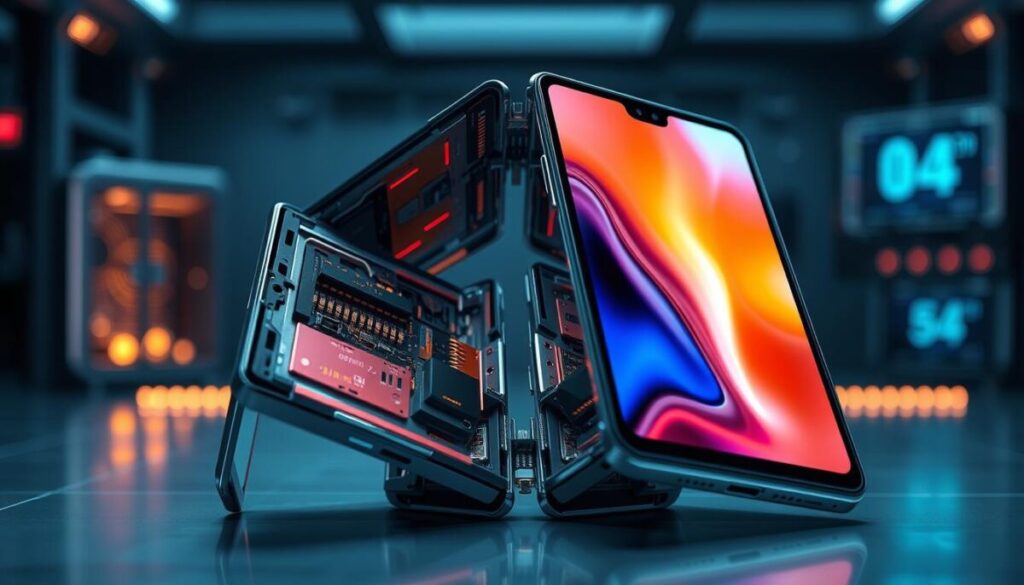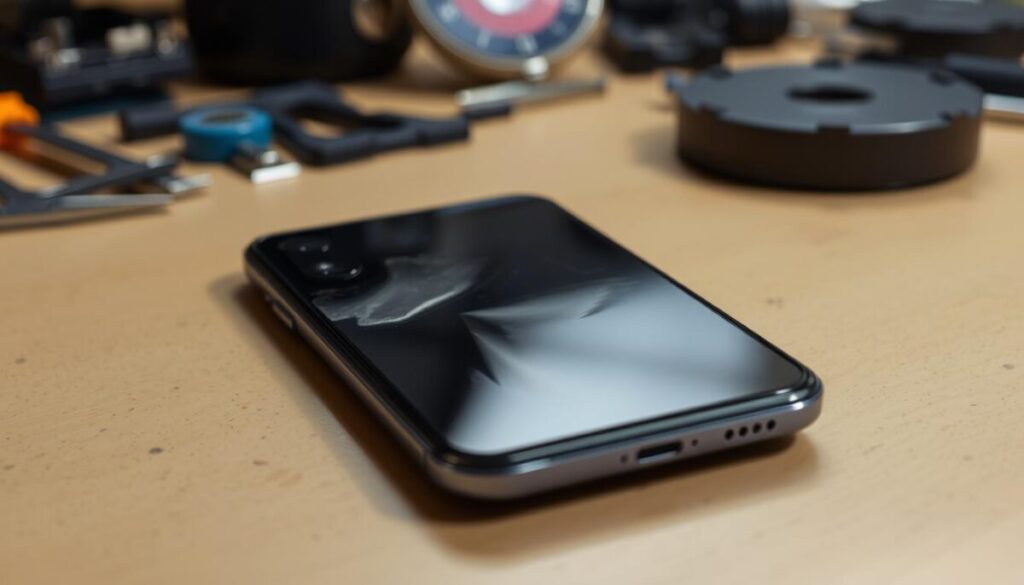The advent of foldable smartphones marks a significant leap in mobile technology. In recent years, pioneering brands have leveraged this innovation to craft devices that merge aesthetics, utility, and portability. This has piqued the interest of tech enthusiasts and casual users alike. The path to today’s flexible display devices started with early ideas in the early 2000s. However, it wasn’t until Royole introduced the FlexPai in October 2018 that the concept gained momentum.
Following Royole’s lead, Samsung unveiled their Infinity Flex Display prototype at their developer conference. This led to the launch of the Samsung Galaxy Fold in February 2019. As the market progressed, Huawei and Motorola entered the foldable phone arena. They brought a new twist to flip phones, incorporating advanced technology and sleek designs. I see this trend as the start of a major shift in how we view and interact with smartphones.
The Evolution of Foldable Smartphones
The journey of foldable smartphones is a captivating tale of design and technological innovation. The idea of foldable devices has been around for decades. However, it wasn’t until recently that advancements made it a reality. The contrast between early and modern foldable devices highlights the field’s rapid evolution.
The early beginnings and initial concepts
The exploration of foldable technology started in the 2000s, with Nokia leading the way. Despite early attempts, these devices were often impractical due to technological hurdles. As the need for new formats grew, the industry made strides toward creating usable foldable smartphones.
Royole FlexPai: The first foldable phone
The Royole FlexPai was launched on October 31, 2018, marking the first foldable phone. Although it was groundbreaking, it faced several challenges, including build quality and software performance issues. Critics noted that early foldable phones were still far from being suitable for daily use.
Samsung’s pivotal role in the innovation
After the FlexPai, Samsung introduced the Galaxy Fold in February 2019. It showcased a robust design and a functional dual display. The Galaxy Fold was the result of years of research, showcasing Samsung’s dedication to foldable technology. Samsung and Huawei’s entry into the market intensified competition, driving further innovation.
Impact of Foldable Smartphones on the Mobile Industry
The advent of foldable smartphones has reshaped consumer interest in mobile technology. These devices offer a unique blend of portability and an improved viewing experience. They appeal to those who value multitasking and media consumption. However, they currently make up only 1% of smartphones in major markets.
Despite their allure, many users still prefer traditional smartphones. This is evident as 55% of foldable phone owners have switched back to conventional devices within a year.
Changing consumer preferences
Consumer dissatisfaction with certain foldable smartphone features is growing. Users often express lower satisfaction with software updates, battery life, and after-sales support compared to high-end conventional models. This trend has led to a shift towards premium brands like Samsung Galaxy S23 Ultra and iPhone 14 Pro Max.
However, 28% of U.S. smartphone users plan to switch to foldable devices soon. This indicates a potential increase in consumer interest as technology advances.
Competition driving innovation and performance
The emergence of foldable smartphones has intensified competition among manufacturers. Samsung dominates the market, shipping over 12.5 million units globally in 2023. Other brands like Huawei, Motorola, and newcomers aim to innovate and improve user experience and performance.
The forecasted 38% increase in foldable smartphone shipments in 2024 highlights the competitive landscape. The market value is expected to reach $28.72 billion in 2024. This growth reflects growing interest in foldable devices, despite initial concerns about cost and durability.
The Technology Behind Foldable Smartphones
The development of foldable smartphones is rooted in groundbreaking advancements in flexible displays and robust engineering. These innovations are key to improving user experience and boosting device performance.
Flexible displays and OLED technology
Flexible displays are at the heart of modern foldable smartphones, enabling innovative designs that merge beauty with utility. Advanced OLED technology powers many of these displays, offering vivid colors and deep contrasts. This technology ensures high-resolution quality even when the display is bent.
The advent of ultra-thin glass (UTG) has transformed display manufacturing. It ensures durability without compromising on visual excellence. This combination allows devices to fold smoothly while delivering an engaging viewing experience.
Durable hinges and advanced engineering
The functionality of foldable devices heavily depends on durable hinges that enable smooth opening and closing. Companies like Samsung have led in this engineering, ensuring their Galaxy Z series models can withstand up to 200,000 folds. This focus on advanced engineering has alleviated initial concerns about durability.
These devices now stand up to daily wear and tear, distinguishing them from traditional phones.

Challenges Facing Foldable Smartphones
The rise of foldable smartphones brings exciting possibilities, yet hurdles block their widespread adoption. Durability is a major concern. Early users faced mechanical failures and screen creasing, casting doubt on their long-term reliability. Despite efforts by manufacturers to improve hinges and materials, doubts about durability persist. Ensuring these phones can handle daily use is crucial to overcoming these hurdles.
Durability and mechanical issues
Devices like the Samsung Galaxy Z Fold and Z Flip have shown progress, supporting up to 200,000 folds. The OnePlus Open can handle up to one million folds. Yet, concerns about their longevity remain. Continuous testing is essential to ensure they work well in both folded and unfolded states. User satisfaction, especially in multi-tasking, is key to addressing these durability concerns.
High costs and market accessibility
Pricing is another major obstacle for foldable technology. Samsung’s Galaxy Fold launched in 2019 at $1,980, equivalent to nearly $2,500 today. This high cost deters budget-conscious buyers. While the Motorola Razr (2023) is more affordable at $400, high-end models still cost around $1,000. Manufacturers must find ways to make these devices more accessible to achieve broader appeal.

The Future of Foldable Smartphones
The future of foldable smartphones looks bright, with companies constantly innovating. We can expect significant improvements in durability and battery life. These advancements will make these devices more attractive to users. As production methods improve, costs should decrease, making these phones more accessible to everyone.
Expected advancements and technology improvements
Leading brands like Samsung, Google, and Motorola are heavily investing in foldable tech. We can look forward to:
- Unbreakable screens that address durability concerns
- Better battery optimization for extended usage
- Enhanced software integrations for a more seamless user experience
- Minimized visible creases on folding screens
Market predictions and trends
The International Data Corporation predicts a surge in foldable device shipments to 25 million by 2024. This is a notable increase from 18.1 million in 2023. Despite 2023’s sales falling short, analysts believe foldables will gain popularity. They offer enhanced productivity, immersive entertainment, and increased portability.
Devices like the Samsung Galaxy Z Fold 6 and Motorola’s Razr show a range of prices. This variety caters to different budgets. As competition intensifies, upcoming models will feature larger external displays, better cameras, and more powerful hardware.
Expected releases include Samsung’s Galaxy Z Fold and Z Flip updates. These will focus on design and performance enhancements. Brands like OnePlus and Google are also preparing updates that meet evolving consumer needs.
The future of foldable smartphones is promising, set to become a staple in the mainstream market. This is thanks to technological advancements and changing consumer habits. The journey for foldable devices is exciting, with many developments on the horizon.
Conclusion
The rise of foldable smartphones is reshaping the mobile technology landscape. With global shipments expected to hit around 25 million units by 2024, consumer interest is skyrocketing. Models like the Samsung Galaxy Fold and the HONOR Magic V2 showcase the potential of foldable tech. They promise a future where smartphones and tablets merge, offering enhanced versatility.
Despite durability and cost hurdles, foldable smartphones are making strides. Samsung and TCL are leading the charge with annual updates and groundbreaking features. The upcoming Galaxy Z Fold 6 is a testament to their commitment to improving user experience and driving innovation in mobile tech.
Foldable smartphones represent a shift towards devices that are both functional and visually appealing. As manufacturers tackle existing challenges, I foresee a bright future for these devices. They will likely lead the way in defining industry trends. Investing in foldable tech means embracing a new era of portable devices that blend innovation with everyday usability.



